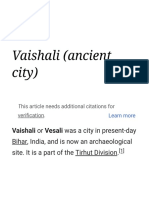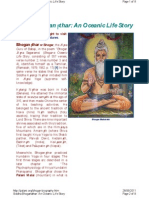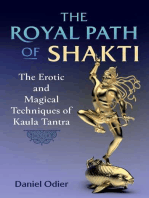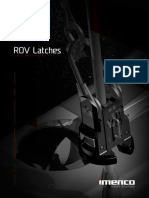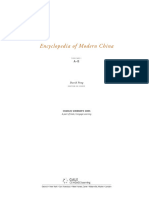Maps of Ancient Buddhist India
Maps of Ancient Buddhist India
Uploaded by
Vaibhav Jayant GupteCopyright:
Available Formats
Maps of Ancient Buddhist India
Maps of Ancient Buddhist India
Uploaded by
Vaibhav Jayant GupteCopyright
Available Formats
Share this document
Did you find this document useful?
Is this content inappropriate?
Copyright:
Available Formats
Maps of Ancient Buddhist India
Maps of Ancient Buddhist India
Uploaded by
Vaibhav Jayant GupteCopyright:
Available Formats
Maps of Ancient Buddhist India
drawn and compiled by
nandajoti Bhikkhu
(Revised August 2008)
Maps of Ancient Buddhist India
Index
The Buddha's Early Career.....5 The Realised One's Rain's Retreats.....6 The Realised One's Last Tour.....8 The Distribution of the Relics.....9 The Four Places that Produce Enthusiasm.....10 Bvar's Students' Walk across Ancient India.....11 The 16 Great States.....12 The Five Great Rivers.....13 Mount Sineru and Lake Anotatta.....15 Asoka's Edicts.....16 Asoka's Missions.....18 Where the Dhammapada-s were found.....21
Maps of Ancient Buddhist India
Preface
Here you will find presented a number of maps of Buddhist places in Ancient India to help as a reference for those interested in understanding the geography and demographic distribution of places and peoples mentioned in the Buddhist texts. A number of them have been prepared specially for this section, and others accompany particular texts and translations that are presented elsewhere on this website. The intention is to add to this section as and when the need arises. I have included modern place names in some of the maps so as to help orientate the reader, who may not be familiar with the geography of India. I have also annotated the maps to give sources and further relevant information that could not be included elsewhere. My main sources for information in compiling the maps have been the following: Geography of Early Buddhism by B.C. Law; Dictionary of Pli Proper Names by G.P. Malalasekera; Buddhist India by T.W. Rhys-Davids; and Middle Land, Middle Way by S. Dhammika; many other books have incidental information, including the various annotated translations I have consulted during the course of this work. I am particularly grateful to Bhante S. Dhammika for checking the maps through for me and making many useful suggestions and corrections, which has helped improve them considerably. nandajoti Bhikkhu May 2008
Maps of Ancient Buddhist India
Maps of Ancient Buddhist India
Tathgatassa Pure Crita The Buddha's Early Career
What follows is based on the account in the Mahkhandhaka section of the Vinaya Mahvagga, and the traditional histories such as the Jtaka Nidakath, and the Jinavasa: After Awakening at the foot of the Bodhi tree in Uruvel the Buddha spent the following 7 weeks in a number of locations in the same area. He then travelled to Isipatana, where his former companions, the group of five (pacavaggiya) ascetics were staying. The walking tour appears to have taken around a week, as he arrived on the Full Moon night of sha. That night he preached his first recorded discourse, and thereby set the Dhamma-Wheel rolling, at the end of which Ata Koa became the first person to attain path and fruit in the present Ssana. In the next few days he and his four companions all became Worthy Ones (Arahanta). The Buddha spent the first Vassna in the Deer-Park at Isipatana, and in a short time converted first Yasa, and then 50 of his friends, who also all became Worthy Ones. At the end of the Rain's Retreat the Buddha walked back to Uruvel, where he converted the three Kassapa brothers and their 1,000 disciples. From there he travelled to the Magadhan capital Rjagaha, where he was presented with his first monastery, the Bamboo Wood (Veuvana) by King Bimbisra.
Maps of Ancient Buddhist India Five months had passed since leaving Isipatana and it was now Springtime. Kudy arrived from Kapilavatthu, and invited the Buddha to return to his home town. There he converted his former Wife, his Father, and ordained his Son, and other family members, including Nanda and nanda. While he was there the rich merchant Anthapiika arrived and invited him to Svatth, where he bought and presented him with the Jeta's Wood monastery. At this point the early histories break off, perhaps because the Ssana was safely established by this time. Although we know a lot about the Buddha's ministry, the chronology is not picked up again until the Mahparinibbnasutta opens about one year before the Final Emancipation at Kusinr.
Tathgatassa Vassan The Realised One's Rain's Retreats
This map shows the various places where the Buddha spent his Rain's Retreats according to the information related in the Introduction to the Commentary on the Buddhavasa, which is also followed by Ven. Medhakara in Jinavasa. Most of them are well known, and appear in the Discourses many times. Of the Retreats we are sure about note that they all were taken in the Middle Lands (Majjhimadesa).
Maps of Ancient Buddhist India Some of the places we cannot identify. These include the 6th retreat on Mount Makula;1 8th at Bhesakal Wood in the Bhagga Country; 13th, 18th and 19th on Mount Cliya.2 Others are only vaguely known, such as Silk-Cotton Wood, Prileyya and Veraj, all of which were around Kosamb. The exact position of av is also not known, but must have been in the Vajj Country where there were many yakkha shrines. According to tradition the 7th Rains Retreat was spent in Tvatisa teaching the Abhidhamma to his Mother, who had been reborn as a Devaputta. The information given in the Commentary inexplicably omits the last Rain's Retreat spent by the Buddha, which was at the village of Beluva, within walking distance of Vesl, as related in the Mahparinibbnasutta. A text and translation of the relevant section of the Commentary to Buddhavasa follows: After setting the Dhamma Wheel Rolling in Isipatana and making 180,000,000 Brahms imbibe the immortal ambrosia during the first Rains Retreat he dwelt at the Deer Park in Isipatana relying on Bras (for alms); the second Rains retreat was in the Great Monastery at Bamboo Wood, relying on Rjagaha; the third and fourth likewise (he was) also there; the fifth was in the Gabled House Hall in the Great Wood relying on Vesl; the sixth on Mount Makula; the seventh in the realm of the 33 gods (Tvatisa); the eighth in the Bhesaka Wood, relying on the Crocodile Hill amongst the Bhaggas; the ninth near Kosamb; the tenth in the Prileyyaka grove; the eleventh in the brhmin village of Na (in Magadh); the twelfth near Veraj; the thirteenth on Mount Cliya; the fourteenth in the great Monastery (near Svatth); the fifteenth near the great city of Kapilavatthu (his home town, amongst the Skiyans); having tamed (the yakkha) avaka and making 84,000 creaturess imbibe the immortal ambrosia, (he spent) the sixteenth at av; the seventeenth was surely near Rjagaha (perhaps in Bamboo Wood); then the eighteenth on mount Cliya; but the nineteenth and twentieth Rains Retreat he dwelt near to Rjagaha (perhaps in Bamboo Wood) ... But from there onwards he surely relied on Svatth dwelling in the Great Monastery in Jeta's Wood and the Eastern Monastery because it had constant supplies (of requisites for the large gathering of monks).
1 2
ChS: Makula. ChS: Clika.
7
Maps of Ancient Buddhist India
Tathgatassa Pacchim Crik The Realised One's Last Tour
The last year of the Buddha's life is recorded in the Mahparinibbnasutta of the Dghanikya (DN 16), which records his last walking tour in the Middle Country (Majjhimadesa). Before the beginning of the Rains Retreat (Vassna) the Buddha walked from Rjagaha to Vesl where he stayed for a number of months. Eventually the Buddha left Vesl and started walking North and attained Complete Emancipation (Parinibbna) at Kusinr. Looking at the map it very much appears as though the Buddha was actually heading for his home town of Kapilavatthu but succumbed to his illness on the way. The Buddha fell ill with dysentry in Pv and according to the very sad story in the Commentary, on the last day of his tour he actually had to sit down and rest no less than 25 times before reaching Kusinr in the evening.
Maps of Ancient Buddhist India
Sarravibhgo The Distribution of the Relics
The exact positions of Pipphalivana, Allakappa, and Vehadpa are not known. One of the more interesting things this map brings out is that Svatth and Bras did not get a share of the relics, and apart from the relics that were taken to Vesl and Rjagaha, all the others were distributed locally. from Mahparinibbnasutta Then the Magadhan King Ajtasattu, the son of Lady Wisdom, made a Shrine for the Gracious One's bodily relics at Rjagaha and held a festival. The Licchavs from Vesl made a Shrine for the Gracious One's bodily relics at Vesl and held a festival. The Sakyas from Kapilavatthu made a Shrine for the Gracious One's bodily relics at Kapilavatthu and held a festival. The Bulas of Allakappa made a Shrine for the Gracious One's bodily relics at Allakappa and held a festival. The Koliyas of Rmagma made a Shrine for the Gracious One's bodily relics at Rmagma and held a festival. The Vehadpaka brahmin made a Shrine for the Gracious One's bodily relics at Vehadpa and held a festival. The Mallas of Pv made a Shrine for the Gracious One's bodily relics at Pv and held a festival.
Maps of Ancient Buddhist India The Mallas of Kusinr made a Shrine for the Gracious One's bodily relics at Kusinr and held a festival. Doa the brahmin made a Shrine for the urn and held a festival. The Moriys of Pipphalivana made a Shrine for the ashes at Pipphalivana and held a festival. Thus there were eight Shrines for the bodily relics, the Vessel Shrine was the ninth, and the Ashes Shrine was the tenth, and so it was former times.
Cattri Savejanyni hnni The Four Places that Produce Enthusiasm
from Mahparinibbnasutta, Section 35: These are the four places, nanda, that are to be seen that produce enthusiasm for a faithful man of good family. Faithful monks, nuns, laymen, and laywomen will come, (thinking): `Here the Realised One was born', `Here the Realised One awoke to the unsurpassed and Perfect Awakening', `Here the Realised One set rolling the Wheel of the Teaching', `Here the Realised One was Completely Emancipated in the Emancipation-element which has no basis for attachment remaining', and whoever, nanda, will die while on pilgrimage to the Shrines with a confident mind they will all, at the break-up of the body, after death, re-arise in a fortunate destiny, in a heavenly world.
10
Maps of Ancient Buddhist India
Bvarissa Mavacrik Jambudpe Bvar's Students' Walk across Ancient India
from Pryanavaggo, verses 31-38: After hearing Bvar's words, the sixteen brahmin students ... set out for the North. From Maka to Patihna first, then on to Mahissati, to Ujjen, and Gonaddha, to Vedisa, and to the place called Vanasa, to Kosamb, and Sketa, and Svatth, the city supreme, to Setabya, and Kapilavatthu, and to the city of Kusinr, to Pv, to Bhoganagara, to Vesl, to the Magadhan city (Rjagaha), and to the Psaka Shrine, delightful, it is the mind's delight. Bvar had left Svatth, the capital of Kosala, some time before and retired to a very remote place on the bank of the Godhvar River, which was about as far south as the Ariyans had penetrated at that time. There students gathered around him, including 16 who became teachers in their own right. When Bvar heard that a Sambuddha had arisen in the world he sent his students to question him. They first headed for Svatth itself, where the Buddha had been staying, but when he saw them coming, realising that they were not mature enough, he withdrew to Rjagaha and to the Psaka Shrine. Their walking tour covered a distance of some 1,800 kilometres.
11
Maps of Ancient Buddhist India
Soasa Mahjanapad The 16 Great States
In two places in the Aguttaranikya (Uposathasutta, Bk. 3.71; Vitthatposathasutta, Bk. 8.42) we find the following list of great states (Mahjanapad): Ag, Magadh, Ks, Kosal, Vajj, Mall, Cet, Vas,3 Kur, Pacl, Macch, Srasen, Assak, Avant, Gandhr, Kamboj. We sometimes come across other forms of this list, so that at Janavasabhasutta (DN 18) only the following ten are mentioned: Ks, Kosal, Vajj, Mall, Cet, Vas, Kur, Pacl, Macch,4 Srasen. Interestingly, the Skiyas and the Koiyans are omitted from these lists, perhaps they were not considered as great states, being too small in size. Below is a list of the State Capitals, and their Kings where they are known. The most important ones by far are the first two. Remember that the Buddha lived for 80 years and the political situation was always changing: Magadh (Capital: Rjagaha; King Bimbisra, later Ajtasattu) Kosal (Capital: Svatth; King Pasenadi) Ag (Capital: Camp) Ks (Capital: Brnas)
3 4
ChS: Vag. ChS: Majjh.
12
Maps of Ancient Buddhist India Vajj (Republic) Mall (Republic) [Skiy (Republic), Koiy (Republic)] Vas (Capital: Kosamb, King Udena) Cet (Sotthivat) Kur (Capital: Indapatta) Pacl Macch (Capital: Viranagara; King Vira) Srasen (Capital: Mathur) Assak (Capital: Potana) Avant (Capital: Ujjen in the North, Mhissat in the South; King Vessabh) Gandhr (Capital: Takkasil) Kamboj.
Paca Mahnad The Five Great Rivers
from Udna 5-5: Uposathasutta (45)
Seyyath pi bhikkhave y kci mahnadiyo, seyyathda: Just as, monks, whatever great rivers there are, that is to say: Gag, Yamun, Aciravat, Sarabh, Mah, The Gag, the Yamun, the Aciravat, the Sarabh, and the Mah,
13
Maps of Ancient Buddhist India t mahsamudda patv jahanti primni nmagottni, having arrived at the great ocean, give up their former lineages and names, mahsamuddo tveva sakha gacchanti, and are then designated as the great ocean, evam-eva kho bhikkhave cattro me va: so, monks, there are these four classes: Khattiy, Brhma, Vess, Sudd, te Tathgatappavedite Khattiyas, Brhmaas, Vessas, and Suddas, who, having gone forth Dhammavinaye agrasm anagriya pabbajitv, from the home to homelessness in the Dhamma and Discipline taught by the Realised One, jahanti purimni nmagottni, give up their former lineages and names, sama Sakyaputtiy tveva sakha gacchanti. and are then designated as Sakyan ascetics. Ya bhikkhave cattro me va: That, monks, there are these four classes: Khattiy, Brhma, Vess, Suddh, te Tathgatappavedite Khattiyas, Brhmaas, Vessas, and Suddas, who, having gone forth Dhammavinaye agrasm anagriya pabbajitv, from the home to homelessness in the Dhamma and Discipline taught by the Realised One, jahanti purimni nmagottni, give up their former lineages and names, sama Sakyaputtiy tveva sakha gacchanti, and are then designated as Sakyan ascetics, ayam-pi bhikkhave imasmi Dhammavinaye catuttho is the fourth wonderful and marvellous thing, monks, acchariyo abbhutadhammo, about this Dhamma and Discipline, ya disv disv bhikkh imasmi Dhammavinaye abhiramanti. which, having seen and considered, the monks delight in this Dhamma and Discipline.
14
Maps of Ancient Buddhist India
Anotattasaro ca Sinerupabbato ca Mount Sineru and Lake Anotatta
The Buddha is said to have traversed the great distance from Uruvel to the Himlayas to spend the day at Lake Anotatta during the time he was trying to convert the Uruvel Kassapa, shortly after the Awakening, but the latter was still not convinced of the Buddha's superiority. It is mentioned as one of the seven great lakes in the Himlayas (AN Bk. 7.66. The others are named as Shapapta, Rathakra, Kaamu, Kula, Chaddanta, Mandkin). In the same Aguttara discourse Mount Sineru is mentioned as the King of Mountains (Pabbatarj). The mountain is also known in the Pi texts as Neru, Mahmeru, Meru and Kelasa. It is identified now with Mount Kailash in western Tibet. The Lake Anotatta, which is identified with Lake Manasarovar is on the rocky plains (siltala) in front of the mountain range. Sineru takes on mythical proportions in the Commentaries, where the Tvatisa Heaven in said to be positioned on its summit, and the abode of the Demons at its base (SnA ii.485).
15
Maps of Ancient Buddhist India
Asokassa Lipiyo Asoka's Edicts
16
Maps of Ancient Buddhist India Translation of Inset written in Brhm script at Girnar (by S. Dhammika): Beloved-of-the-Gods, King Piyadasi, has caused this Dhamma edict to be written. Here (in my domain) no living beings are to be slaughtered or offered in sacrifice. Nor should festivals be held, for Beloved-of-the-Gods, King Piyadasi, sees much to object to in such festivals, although there are some festivals that Beloved-of-the-Gods, King Piyadasi, does approve of. Formerly, in the kitchen of Beloved-of-the-Gods, King Piyadasi, hundreds of thousands of animals were killed every day to make curry. But now with the writing of this Dhamma edict only three creatures, two peacocks and a deer are killed, and the deer not always. And in time, not even these three creatures will be killed.
Kandahar Inscription
Translation of Inscription written in Greek (top) and Aramaic (bottom) at Kandahar (by G.P. Carratelli): Ten years (of reign) having been completed, King Piodasses (Ashoka) made known (the doctrine of) Piety (Eusebeia) to men; and from this moment he has made men more pious, and everything thrives throughout the whole world. And the king abstains from (killing) living beings, and other men and those who (are) huntsmen and fishermen of the king have desisted from hunting. And if some (were) intemperate, they have ceased from their intemperance as was in their power; and obedient to their father and mother and to the elders, in opposition to the past also in the future, by so acting on every occasion, they will live better and more happily.
17
Maps of Ancient Buddhist India
Asokassa Pesan Asoka's Missions
18
Maps of Ancient Buddhist India There is a discrepency about the Asokan Missions. According to the Edicts King Asoka himself sent them out, but according to Pi sources, like the Vinayanidna and Mahvasa it was his preceptor and advisor, the elder Moggaliputtatissa. Here is a summary of the monks involved and the places they went to according to the Mahvasa: Majjhantika to Kasmra and Gandhra Mahdeva to Mahisamaala Rakkhita to Vanavs Dhammarakkhita to Aparantik Mahdhammarakkhita to Mahraha Mahrakkhita to Yonaloka Majjhima to the Himlayas Soa and Uttara to Suvaabhmi Mahinda, Ihiya, Uttiya, Sambala and Bhaddasla to Lakdpa.
from Mahvasa, XII, verses 1-8:
Thero Moggaliputto so, Jinassanajotako, The elder Moggaliputta, the light of the Victor's Dispensation, Nihpetvna Sagti, pekkhamno angata. Having brought the (3rd) Council to a close, looked towards the future. Ssanassa patihna paccantesu avekkhiya Having seen the establishment of the Dispensation in the border countries Pesesi Kattike mse te te there tahi tahi. During the month of Kattika (November) he sent various elders here and there. Thera Kasmragandhra Majjhantikam-apesayi, He sent the elder Majjhantika to Kasmra and Gandhra, Apesay Mahdevatthera Mahisamaala. He sent the elder Mahdeva to Mahisamaala. Vanavsi apesayi thera Rakkhitanmaka To Vanavs he sent the elder by the name of Rakkhita Tathparantaka Yonadhammarakkhitanmaka. But the Greek by the name of Dhammarakkhita to Aparantik. Mahraha Mahdhammarakkhitattheranmaka, To Mahraha (he sent) the elder by the name of Mahdhammarakkhita, Mahrakkhitathera ta Yonalokam-apesayi. He sent to the world of the Greeks the elder Mahrakkhita.
19
Maps of Ancient Buddhist India Pesesi Majjhima thera Himavantapadesaka, He sent the elder Majjhima to the place of the snows (Himlaya) Suvaabhmi there dve Soam-uttaram-eva ca. To Suvaabhmi (he sent) two elders, Soa and Uttara. Mahmahindatthera ta thera Ihiyam-Uttiya, That Great Elder Mahinda, Ihiya and Uttiya, Sambala Bhaddasla-ca, sake saddhivihrike, Sambala and Bhaddasla,5 his attendant monks, Lakdpe manuamhi manua Jinassana * He sent these five elders, (saying): You must establish Patihpetha tumhe ti paca there apesayi. In the pleasant Island of (r) Lak the pleasant Dispensation of the Victor.
It appears two others accompanied Mahinda to Lak, they are the novice Sumana, and the upsaka Bhanduka.
20
Maps of Ancient Buddhist India
Dharmapadni yatanni Where the Dhammapada-s were found
21
Maps of Ancient Buddhist India
22
Maps of Ancient Buddhist India The Buddha taught mainly in and around the North-Eastern area of India which was known as the Majjhimadesa (the Middle Country), and after his Final Emancipation his teachings were originally collected there. It is curious indeed that although first taught and collected in India none of the texts we now possess today actually come from there, but have survived in the border countries long after all traces of the books were lost in their Homeland in the Middle Ages. The Pi Tipiaka has been passed down through the r Lakan Sagha; various Sankritised Prakrit texts, which were written down on birch bark, survived in the deserts in Central Asia; and others rescensions have been found in Nepal and Tibet. The oldest book that has come down to us from Ancient times is a rescension of the Dhammapada preserved in the Gndhr dialect. Unfortunately for us it was ripped into 3 pieces and sold off to explorers in the late 19th century; one part went to Paris, another went to St. Petersburg, and a third part went missing altogether. The edition of the text we now know as the Patna Dhammapada was found in an unknown Tibetan monastery by Rhula Sasktyana sometime in the 1930s. There is one set of photographs of the work,6 and parts of it are obscured so that they cannot be read properly. What happened to the work after the Chinese invasion of Tibet in the 1950s is not known at present. It was possibly removed to Beijing, but there is no confirmation of this. Literally hundreds of manuscript fragments of the Udnavarga have been found in the Central Asian deserts, which testifies to the popularity of the work. Piecing them all together again to form a coherent text was a mammoth undertaking performed by Dr. Bernhard in the 1950s (published 1965-67). It appears now however that he has mixed up two different rescensions of the work7 so that the value of his undertaking has been somewhat diminished with time. Recently a new edition has been made of one of the rescensions by H. Hakatani entitled Udanavarga de Subasi.8 The testimonies for the Pi rescension of the work were mainly written on perishable olaleaves and date back only a few centuries, but there are very many of them, and they also are corrobated by other works, so there can be no doubt about the age of the work. It appears that the r Lakan Sagha has very faithfully passed the work down over the millennium, which we can be sure of, as the text contains many readings that are unmetrical and even ungrammatical, but which have not been cleaned up or revised by the recitors, which they would have been had the texts been tampered with.
The name is derived from the current location of the photographs in the J.P. Jayaswal Research Institute of Patna. Lambert Schmithausen 1970: Zu den Rezensionen des Udanavarga in Wiener Zeitschrift fur die Kunde Sudasiens, vol 14 pp 47-124. Published by Publications de l'Institut de civilisation indienne, Paris.
23
You might also like
- 'Southland Tales' Prequel Script, by Richard KellyDocument119 pages'Southland Tales' Prequel Script, by Richard KellyMotherboardTV100% (3)
- Svayambhu PuranaDocument9 pagesSvayambhu PuranaMin Bahadur shakya89% (9)
- Cida Formula Method For Adjustments To Contract Price Due To Fluctuation in PricesDocument58 pagesCida Formula Method For Adjustments To Contract Price Due To Fluctuation in PricesSahan89% (9)
- D9102 User Manual: 1. USB Interface 2. SIM Card 3. Modem Cap 4. Guide Light 5. Cover of SIM CardDocument5 pagesD9102 User Manual: 1. USB Interface 2. SIM Card 3. Modem Cap 4. Guide Light 5. Cover of SIM CardInussi Mitas Júnior100% (1)
- Balabhadra Upasana and TulasikshetraDocument7 pagesBalabhadra Upasana and TulasikshetraPadmanav TripathyNo ratings yet
- Maps of Ancient Buddhist IndiaDocument40 pagesMaps of Ancient Buddhist IndiaSameera Weerakoon100% (2)
- Cha-Kesa Dhatu Va SaDocument15 pagesCha-Kesa Dhatu Va SaNitin B maske100% (2)
- Aśvagho A - WikipediaDocument3 pagesAśvagho A - WikipediaWilhelm Richard WagnerNo ratings yet
- Mandala 6 BookDocument258 pagesMandala 6 BookUday DokrasNo ratings yet
- Who Were Upagupta and His AsokaDocument24 pagesWho Were Upagupta and His AsokaJigdrel770% (1)
- A Buddhist Land of RakhaingDocument8 pagesA Buddhist Land of Rakhaingakar PhyoeNo ratings yet
- Stupas in NepalDocument16 pagesStupas in NepalNalin HettiarachchiNo ratings yet
- Article - Who Were Upagupta and His AshokaDocument24 pagesArticle - Who Were Upagupta and His AshokaMonal BhoyarNo ratings yet
- Singh Rana P B and Rana Pravin SDocument38 pagesSingh Rana P B and Rana Pravin SProf. Ratnasiri ArangalaNo ratings yet
- Sanga RulesDocument114 pagesSanga RulesSatheesh VagiNo ratings yet
- Abhishek History NotesDocument126 pagesAbhishek History NotessahilNo ratings yet
- Bannanje Govindacharya: (Life and Teachings)Document31 pagesBannanje Govindacharya: (Life and Teachings)prasadkulkarnigitNo ratings yet
- Lumbini The Birth-Place of Lord Buddha PDFDocument16 pagesLumbini The Birth-Place of Lord Buddha PDFMohit SunuwarNo ratings yet
- Mythological Accounts of Buddhism in NepalDocument9 pagesMythological Accounts of Buddhism in NepalMilan ShakyaNo ratings yet
- An Introduction To BuddhismDocument6 pagesAn Introduction To BuddhismRichelle PerezNo ratings yet
- Mataya Festival of PatanDocument7 pagesMataya Festival of PatanMin Bahadur Shakya100% (1)
- Section C Buddhism in Nepal: A Presentation by Mahendra Ratna ShakyaDocument24 pagesSection C Buddhism in Nepal: A Presentation by Mahendra Ratna ShakyaNarayan Lamichhane0% (1)
- Evolution of BuddhismDocument9 pagesEvolution of BuddhismdvdmegaNo ratings yet
- Paper 1Document11 pagesPaper 1G G HegdeNo ratings yet
- BuddhismDocument2 pagesBuddhismAshok BehuriaNo ratings yet
- A History of Bodhi GayaDocument4 pagesA History of Bodhi GayaSatadal GuptaNo ratings yet
- Enugula Veeraswamy SJournal Kasiyatra CharitraDocument299 pagesEnugula Veeraswamy SJournal Kasiyatra CharitraBranko NikolicNo ratings yet
- Buddhit Symbol AssignmentDocument15 pagesBuddhit Symbol Assignment000end100% (1)
- Saidai TNPSC NotesDocument42 pagesSaidai TNPSC Notesshardha100% (4)
- Nalanda University-English PDFDocument7 pagesNalanda University-English PDFAmit DasNo ratings yet
- Chaitanya MahaprabhuDocument4 pagesChaitanya Mahaprabhusayanmukherjee5384No ratings yet
- 30 42Document13 pages30 42Nikhil ShreeNo ratings yet
- MT KailashDocument19 pagesMT Kailashsachin khuranaNo ratings yet
- BuddhismDocument4 pagesBuddhismArjence JannaeaNo ratings yet
- Spread of Buddhism in The Southeast Asia - A HistoryDocument16 pagesSpread of Buddhism in The Southeast Asia - A HistoryMilan Shakya100% (4)
- Notes History NCERTDocument4 pagesNotes History NCERTGautam Kumar SinghNo ratings yet
- Indic BuddhismDocument15 pagesIndic BuddhismMin Bahadur shakyaNo ratings yet
- Aśvagho ADocument6 pagesAśvagho ABindu NeNo ratings yet
- Gour Govinda Swami - Who Was He ?Document52 pagesGour Govinda Swami - Who Was He ?Radhe GovindaNo ratings yet
- In The Footsteps of The BuddhaDocument68 pagesIn The Footsteps of The Buddhakimong123No ratings yet
- Origins of Ten Buddhist SchoolsDocument8 pagesOrigins of Ten Buddhist SchoolsHoang NguyenNo ratings yet
- Swayambhu NathDocument6 pagesSwayambhu NathJen PokharelNo ratings yet
- Untold Mysteries of Indian TemplesDocument3 pagesUntold Mysteries of Indian TemplesPartha Palodhi0% (1)
- Tantric Buddhist Influence On Sri LankanDocument12 pagesTantric Buddhist Influence On Sri Lankanေအာင္ခန္႔ န.ပ.သ မန္းNo ratings yet
- Vaishali (Ancient City) - WikipediaDocument31 pagesVaishali (Ancient City) - WikipediaVipul RajputNo ratings yet
- Remarks About The History of SarvāsDocument14 pagesRemarks About The History of SarvāsSuporn BylpNo ratings yet
- Bhogar BiographyDocument8 pagesBhogar BiographyArsanaaki MaryNo ratings yet
- Arniko in Wutai ShanDocument9 pagesArniko in Wutai ShanMin Bahadur ShakyaNo ratings yet
- Asvaghosas GoldDocument451 pagesAsvaghosas GoldNicolae GeorgeNo ratings yet
- History Fifth For ExamDocument6 pagesHistory Fifth For Examvenkhanticara733No ratings yet
- The Buddha's Path of Virtue: A Translation of the DhammapadaFrom EverandThe Buddha's Path of Virtue: A Translation of the DhammapadaNo ratings yet
- The Royal Path of Shakti: The Erotic and Magical Techniques of Kaula TantraFrom EverandThe Royal Path of Shakti: The Erotic and Magical Techniques of Kaula TantraNo ratings yet
- Boudhanath: A virtual tour of one of the most sacred Buddhist Pilgrimage sites in the worldFrom EverandBoudhanath: A virtual tour of one of the most sacred Buddhist Pilgrimage sites in the worldNo ratings yet
- FJP 2401 Accounts - Question Paper.Document9 pagesFJP 2401 Accounts - Question Paper.utsavnai941100% (1)
- Md. Rahat Khan: Mailing AddressDocument2 pagesMd. Rahat Khan: Mailing AddressRimon R RahadNo ratings yet
- MatLab and Solving EquationsDocument170 pagesMatLab and Solving EquationsJulia-e Regina-e AlexandreNo ratings yet
- No One Left To TellDocument455 pagesNo One Left To Tellfypbz6dncsNo ratings yet
- Hydrauliske ServomekanismerDocument98 pagesHydrauliske ServomekanismerMike Fredskilde100% (1)
- FrenchportculdocDocument2 pagesFrenchportculdocapi-242027531No ratings yet
- Recapitulation Sheet Class IV 06.04.21Document4 pagesRecapitulation Sheet Class IV 06.04.21Anishka GuptaNo ratings yet
- JSREP Volume 39 Issue 188ج1 Pages 360-406Document48 pagesJSREP Volume 39 Issue 188ج1 Pages 360-406raghadamarsalihNo ratings yet
- MSBP - Assignment Brief - V1.1 - Approved - 20240314Document15 pagesMSBP - Assignment Brief - V1.1 - Approved - 20240314amraalrahbi58No ratings yet
- 5th Sem CN Lab Manual 2021-22Document69 pages5th Sem CN Lab Manual 2021-22Divya-Kalash -1BY19IS055100% (1)
- Transport Economics For Logistics and Logistician SDocument213 pagesTransport Economics For Logistics and Logistician SMüge ÖzbeklerNo ratings yet
- Sin 2 1 Cos 2: Graphing Sine and Cosine Worksheet #1 Fill in The Blanks and GraphDocument4 pagesSin 2 1 Cos 2: Graphing Sine and Cosine Worksheet #1 Fill in The Blanks and GraphAPCommentatorNo ratings yet
- Frank Kajembe ResearchDocument33 pagesFrank Kajembe ResearchAFROIL MUSOMANo ratings yet
- Mapeh 4TH Quarter, Grade 8Document11 pagesMapeh 4TH Quarter, Grade 8auxiee yvieNo ratings yet
- BSNL Postpaid PlanDocument7 pagesBSNL Postpaid PlanChandra ReddyNo ratings yet
- 12 585 Rov Latches Brochure v3 Web 1 PDFDocument8 pages12 585 Rov Latches Brochure v3 Web 1 PDFIZayvenkoNo ratings yet
- MoneseDocument1 pageMonesequxgknghmhjNo ratings yet
- Allergic PDFDocument17 pagesAllergic PDFSiska HarapanNo ratings yet
- Wsscomp WP Cms AeDocument24 pagesWsscomp WP Cms Aeziyad benkhadajNo ratings yet
- Scientific Legal and Ethical ConcernsDocument23 pagesScientific Legal and Ethical ConcernsAli BabaNo ratings yet
- Pong 2009 HistoryDocument24 pagesPong 2009 History9zp8zvf7w6No ratings yet
- SH42165895 - Hindu, Hindi, Kayastha, Groom From Pune, India PDFDocument3 pagesSH42165895 - Hindu, Hindi, Kayastha, Groom From Pune, India PDFSantosh SrivastavaNo ratings yet
- Autobiography of Gregoria de Jesus PDFDocument2 pagesAutobiography of Gregoria de Jesus PDFvenus revillaNo ratings yet
- Ethnographic Portfolio - Cuban Salsa MusicDocument10 pagesEthnographic Portfolio - Cuban Salsa Musicsjm198No ratings yet
- SaP-Report Membrane Structures PDFDocument279 pagesSaP-Report Membrane Structures PDFjorgeNo ratings yet
- 4398 Pulligfall 09Document10 pages4398 Pulligfall 09rpraveen1984No ratings yet
- From Silence To Sound - Beethoven's BeginningsDocument450 pagesFrom Silence To Sound - Beethoven's BeginningsWolfgang Amadeus Mozart100% (1)













































